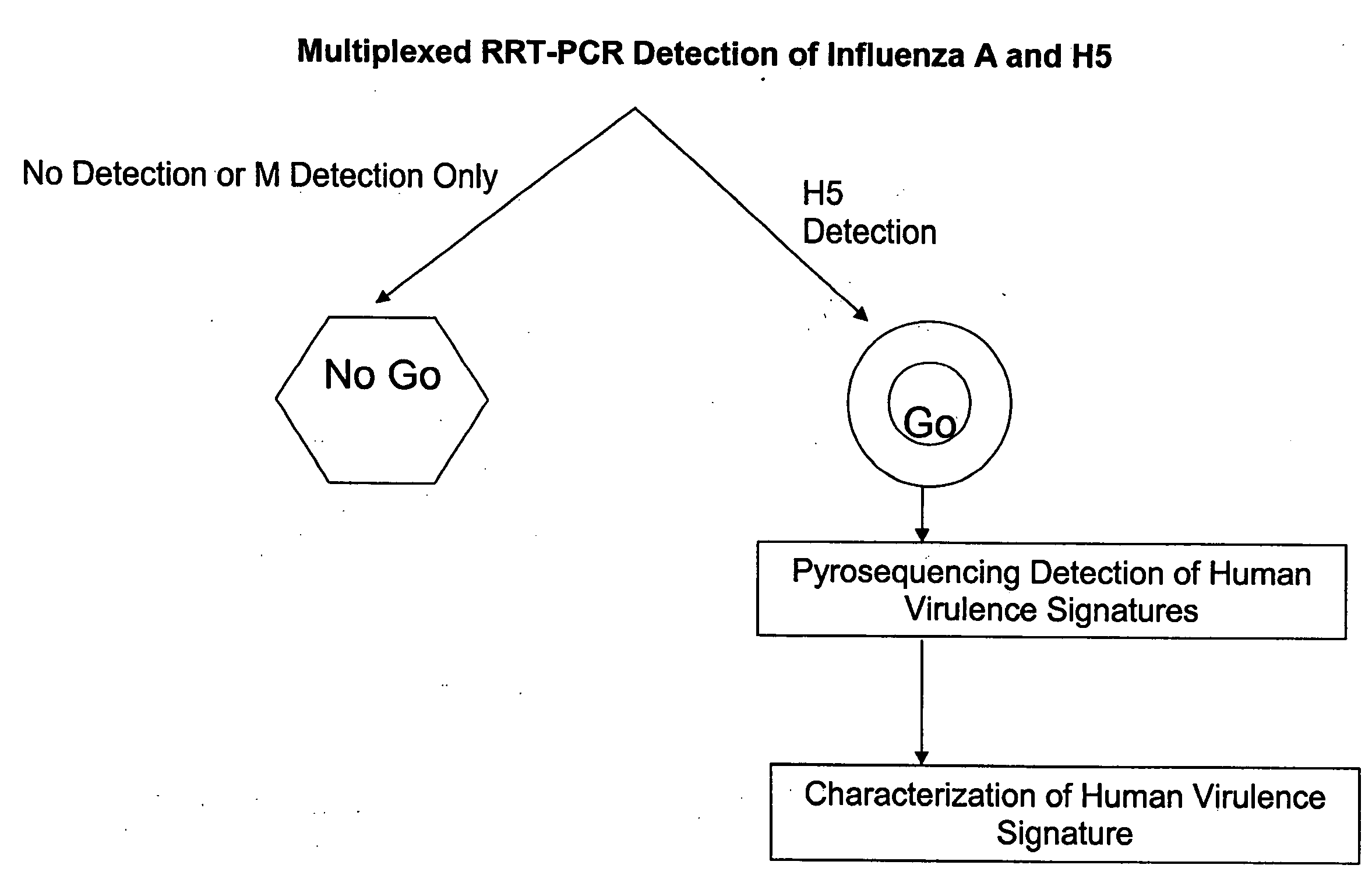Method for detecting emerging pandemic influenza
a pandemic and emerging virus technology, applied in the field of emerging pandemic influenza detection, can solve the problems of mild illness, high fatality rate of currently circulating h5n1 virus in infected humans, and significant public health threa
- Summary
- Abstract
- Description
- Claims
- Application Information
AI Technical Summary
Benefits of technology
Problems solved by technology
Method used
Image
Examples
example 1
Primer and Probe Preparation
[0028]Primer and probe stocks need to be prepared under carefully controlled conditions to minimize any chance of contamination. Each primer probe mix will contain specific primers and probes for the target of interest as well as the water needed for the reaction. Each primer mix will contain specific primers for the target of interest. Master mix with enzymes and deoxyribonucleotide triphosphates (dNTPs), as well as buffers for the completion of the RRT-PCR reaction are added just prior to use.
[0029]Probes are ordered from Applied Biosystems, Inc., 850 Lincoln Center Drive, Foster City Calif. 94404, (www.appliedbiosystems.com). All probes are delivered in liquid format.
[0030]Primers are ordered from Integrated DNA Technologies (IDT), 1710 Commercial Park, Coralville Iowa 52241, (www.idtdna.com). Primers are received dry and stored at room temperature until reconstituted.
[0031]Using the tables below, mix components to create 20 reactions of primer probe m...
example 2
RNA Extraction
[0033]The following are standard operating procedures for the extraction of RNA from viral samples using the Qiagen QIAamp® Viral RNA Mini Kit. Extreme care must be taken when working with all reagents and samples as RNA is easily degraded. Gloves must be worn at all times. This procedure was modified from the Qiagen QiAamp® Viral RNA Mini Handbook.
[0034]Prepare a solution of at least 052% sodium hypochlorite (this represents a 1:10 dilution of household or ultra bleach and is referred to herein as ‘10% bleach.’)
[0035]Clean BSC with 10% bleach, then RNase Zap and finally 70% isopropanol solution. Clean all items prior to placing in BSC with 10% bleach, then RNase Zap and finally 70% isopropanol solution, including pipettes, tips, sharps container, microcentrifuge tube rack, marker, vortexer, tubes and reagents. Change gloves.
[0036]Add 310 μL of Buffer AVE to each Carrier RNA tube. This will make a solution of 1 μg / μL. Vortex each tube for 10 seconds to make even soluti...
example 3
RRT-CRT Procedure
[0059]Tier One testing of extracted viral samples using Reverse Transcriptase-Polymerase Chain Reaction (RT-PCR). Testing is performed using the Applied Biosystems, Inc. Taqman® One-Step RT-PCR Master Mix Reagents Kit.
[0060]Calculation of Reactions Needed:
[0061]To calculate the number of reactions needed for each target, use the number of samples plus the number of mock extraction controls, plus one positive control and two No Template Controls (NTCs) per plate. If this number is under 100, add 10% to get the final number of reactions to prepare. If the number is over 100, add 15% to get final number of reactions to prepare. Fill out a coversheet with the plate layout of samples and controls as well as the number of reactions of each target to prepare and the volumes necessary.
[0062]Master Mix is Prepared with the Following Volumes per Reaction:
[0063]25 μl 2× universal Master Mix with no AMPerase UNG
[0064]1.25 μl 40× MultiScribe and RNase Inhibitor Mix
[0065]10 μl wo...
PUM
| Property | Measurement | Unit |
|---|---|---|
| total volume | aaaaa | aaaaa |
| total volume | aaaaa | aaaaa |
| total volume | aaaaa | aaaaa |
Abstract
Description
Claims
Application Information
 Login to View More
Login to View More - R&D
- Intellectual Property
- Life Sciences
- Materials
- Tech Scout
- Unparalleled Data Quality
- Higher Quality Content
- 60% Fewer Hallucinations
Browse by: Latest US Patents, China's latest patents, Technical Efficacy Thesaurus, Application Domain, Technology Topic, Popular Technical Reports.
© 2025 PatSnap. All rights reserved.Legal|Privacy policy|Modern Slavery Act Transparency Statement|Sitemap|About US| Contact US: help@patsnap.com



